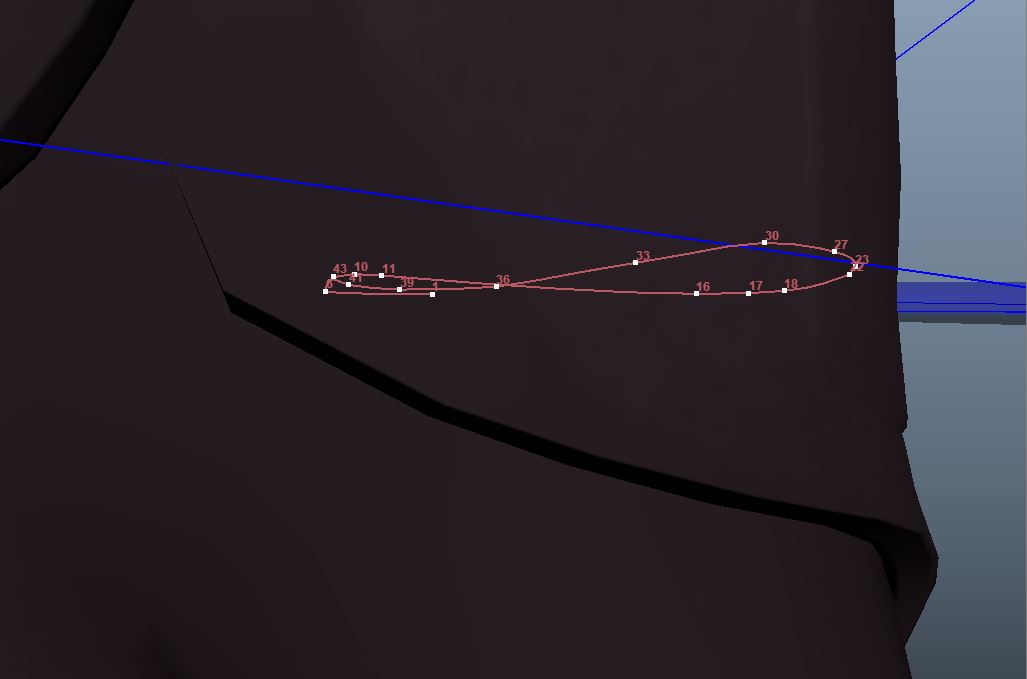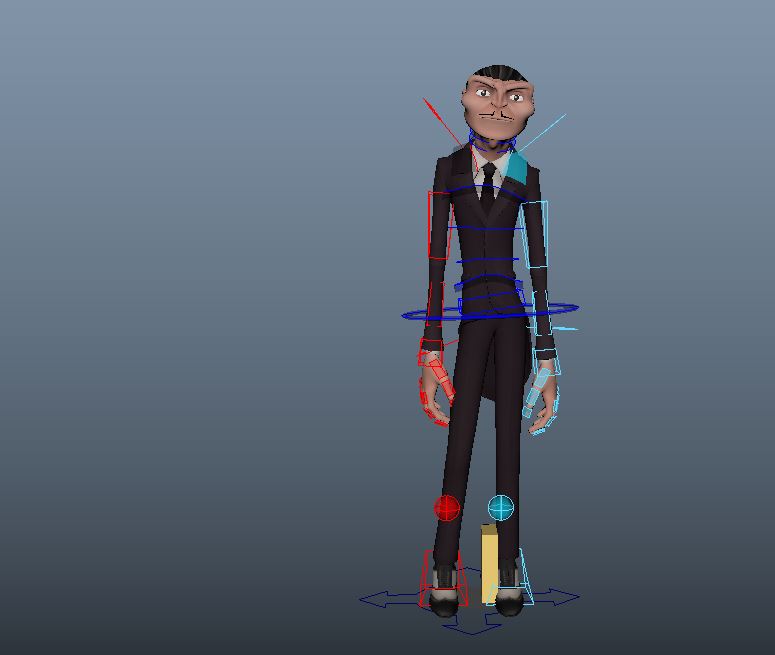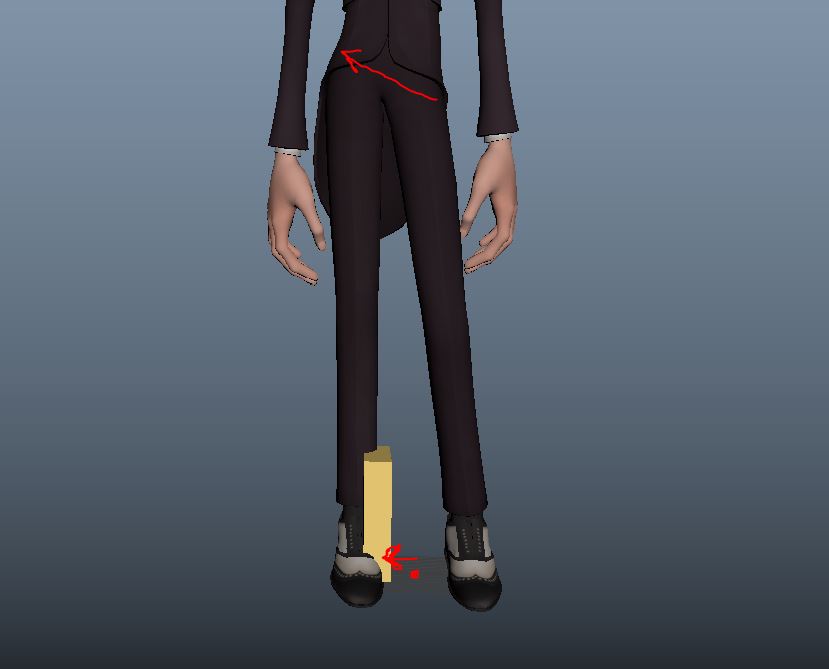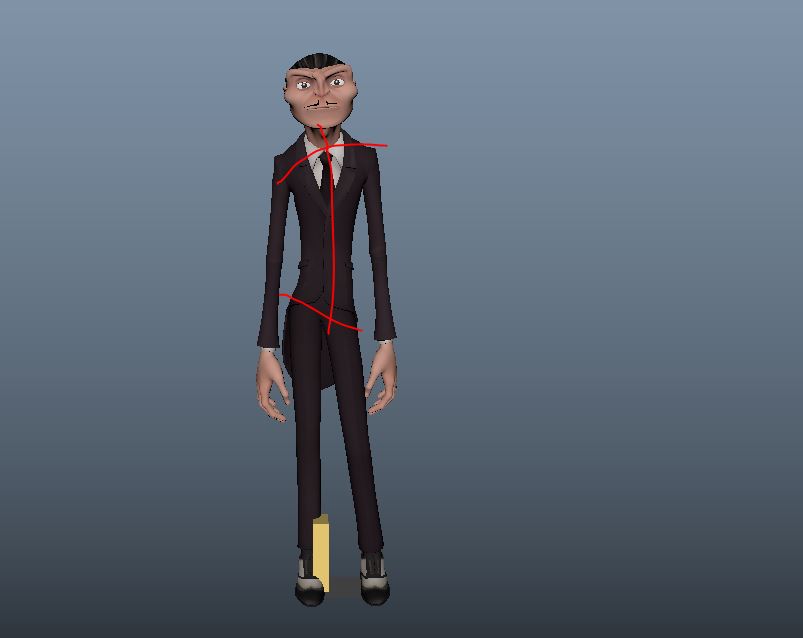Assignment #5: Basic Walk Cycle
Assigned: Tuesday, October 30th, 2018
Due: Tuesday, November 6th @ 10:00 AM
Resources:
- Outline
- Walk cycle "contact method" poses.
- Front view of shoulders and hips
- Mini tutorial on getting your walk animation to cycle when you are finished.
- 11 Second Club Articles
- Richard Williams Animator's Survival Kit
- Walks (pg. 102-111)
- Walks (pg. 102-111)
Weight Shift Exercise
One of the most important concepts of a walk (and just about any kind of body mechanics assignment) is weight shift. There is more to weight shift than just moving side to side - the hips, spine, legs, and feet are all involved.
Start out by downloading this maya file, which is set up with 3 extreme poses.
You will be adding in breakdowns to create two successive shifts in weight - the first coming from a step out with the left leg, and the second one returning to lean on the right leg. Tracking your arcs will help you immensely here. The COG should move in an arcing motion path that looks somewhat like a thin infinity sign.

Use the Center_of_gravity_indicator (the yellow cube by Corruption's feet) to help you get a sense for where the weight is. Make sure to pose the COG in a way that makes sense for what the body is doing. There should be a very short amount of time during which the character is out of balance or "falling" to land on the foot that is stepping out. At any other point in time, the character should feel well grounded and in balance.

Next, comes the hips. The rotation in the hips is essential to getting the feel of a weight shift, and it's a part that many new animators forget to pose. The hips will tend to favor the side the weight is on - so if you take a look at the existing poses, the hips shift upwards towards the right when the weight is on the right leg, and shift upwards towards the left when the weight is on the left leg.

Don't forget your spine. Make sure that you have a good line of action throughout the animation, and that you're using the upper body to counterbalance the offset weight of the COG. If the COG shifts to put weight on the left leg, the spine will curve back towards the right to counterbalance, and vice versa.

Make sure to pose the left foot throughout the step to the left. It should not just slide across the ground - have it roll off the ball of the foot, come up and over, then land in its ending position before the COG moves completely over the left leg. Try getting up and seeing how your weight shifts when you step out with one leg - where is your center of gravity? How does your foot move? Which part of your body leads, and what follows?
You may pose out the arms if you'd like, but it is not mandatory as the main focus of this exercise is to get you comfortable with moving the COG, hips, and spine during weight shifts. Please take the time to understand how the body moves when shifting weight and figuring out how to translate that into your poses because weight shifts will be integral to your next few assignments as well. Feel free to ask a TA for help with the concepts if you're confused!
Once you've gotten to a point where the animation feels fluid, save your scene and playblast from the two render cams provided.
Walk Cycle Assignment
Walk cycles are very important in animation. They are important not just because they are a common type of motion, but because they reinforce many of the motion principles you learned. Squash and stretch, arcs, overlapping action, follow through, timing, and weight all play big roles.
Walks are a particularly
complicated motion with a vast amount of different styles - many with
only the subtlest of differences. However, this week you will be working on what is known as a "vanilla" walk cycle. This is just a plain walk that focuses on the mechanics of the motion itself without any overt stylization.
Part 1: Take Video Reference
Reality is always the foundation on which to start when approaching any sort of animated movement. Starting this week, video reference will become a critical tool that helps you plan and execute more believable motion.
What to do:
-
Take reference of yourself doing a normal walk from both a front and side view.
Keep in mind that for this particular walk you are trying to understand
the mechanics of a walk itself, so try not to get too creative. Just
walk as you would normally.
Study this reference exhaustively. Pay attention to things like the rotation of your hips versus the rotation of your shoulders, how your hips shift and orient depending on where the weight is (from both the front and the side), and how your arms swing.
Part 2: Planning Sheet
As with your previous animations, you will start by drawing out a planning sheet. Luckily walk cycles have been done so often and are so important that there are already a few established ways of approaching them.
Read the section on walks in the Animator's Survival Kit. You will be using what Richard Williams calls the "contact method". A walk cycle has four basic poses: contact, down, passing, and up. Each given step in the contact method starts and ends with the contact pose, coming out to a total of eight poses in one cycle.
Now, it's time to find these main poses in your own video reference. Upload your video reference to Syncsketch, an online app that allows you to scrub through videos and draw over them. Find the contact, down, passing, and up poses in your video reference and draw over them, taking note of the position of your hips, shoulders, arms, legs, and head.
Finally, draw a planning sheet for Corruption using the contact method, using poses based on your Syncsketch drawovers. Include both a front and a side view. Refer back to your video reference as you do this. Though everybody walks slightly differently, plan to animate as normal of a walk as possible: medium pace, arm swing that is not completely stiff, etc.
Part 3: Animate
With reference and planning finished, it is time to animate.
- Start by blocking in the contact poses. As with
the previous assignments you will being using the Corruption rig. Use your planning sheet as a starting point, but as before feel free to deviate as you discover what works best.
- This involves completing two full steps, after which the animation will repeat. There will be eight
unique poses. The final ninth pose should be identical to the first
contact pose only with shifted Z translate - this will be essential in
eventually getting the cycle to loop.
- Your character must walk across the screen and not in place. This way you won't have to worry about sliding feet.
- As far as the workflow, you may find it useful to have your planning sheet and video
reference paused in one monitor while you pose the character in the
other. Exaggerate details where necessary; don't just do a one-to-one
translation (due to differing proportions this would be impossible anyway).
- Don't neglect the weight shifts and leg positions in the front view!
Pay special attention to how the hips are moving and rotating at all
times.
- Break the elbow joint for one or two frames to exaggerate the overlapping action of the arm swing.
- When you are finished, save out a copy of your Maya file with just these poses.
- This involves completing two full steps, after which the animation will repeat. There will be eight
unique poses. The final ninth pose should be identical to the first
contact pose only with shifted Z translate - this will be essential in
eventually getting the cycle to loop.
- Add breakdowns to your animation. Make sure the motion looks good from all angles (side, front, perspective). Insert breakdowns when needed to help define motion arcs and overlap as you did for the forward jump.
- Polish. After adding enough breakdowns to your animation that it plays smoothly and clearly demonstrates your timing and spacing, check in with a TA if you are able to, and move on to polishing. Track your arcs, make sure all parts of the body move smoothly, fix any knee pops, refine the overlap in the arms, etc. Refer to this Polish Checklist and make sure your animation is looking smooth and exhibiting correct body mechanics.
Grading Criteria and Turn-In Checklist:
You will be submitting your files to Canvas. Below is a list of criteria we will be using for grading, in addition to a list of the files you will need to turn in for each part of the assignment along with naming specifications.
Also indicated are the minimum requirements for what we expect to review for your motion check-in.
Motion Check-In:
- Video Reference in Syncsketch with drawovers.
- First pass of the contact poses OR breakdowns for weight shift assignment
Part 1: Video Reference
- For Turn-In
- [lastname]_[firstname]_front_ref.avi
- [lastname]_[firstname]_side_ref.avi
Part 2: Planning Sheet and Syncsketch
- Front and side view of contact poses
- Eight poses for each view
- Links to Syncsketch drawovers of main poses
- For Turn-In
- [lastname]_[firstname]_planning_sheet.jpg
- [lastname]_[firstname]_links.txt
Part 3: Animate (Contacts and Breakdowns)
- For Turn-In
- [lastname]_[firstname]_blocking.ma
(Maya file with contact poses) - [lastname]_[firstname]_blocking.avi
(Playblast with contact poses *PLEASE LEAVE IN STEPPED MODE* -- Clean, fully framed, 1280x720 resolution) - [lastname]_[firstname]_polish.ma
(Maya file with polished, cycled walk) - [lastname]_[firstname]_polish.avi
(Playblast with polished walk cycle, 100 frames -- Clean, fully framed, 1280x720 resolution, static camera, anims hidden)
Grading Criteria
- Weight Shift
- Arcs, timing, spacing of COG
- Hips rotating to support weight
- Left foot posed with correct timing and spacing
- Straight leg to show support of weight
- Walk Cycle
- Full body posing
- No sliding feet
- All anims keyed on each pose (for extremes and breakdowns)
- Good timing/spacing, moderately paced walk
- Weight shift
- 24 frames per second
- No partial frames
- Up/down of waist through space
- Foot movement
- Successive breaking of joints
- Head movement isn't jerky